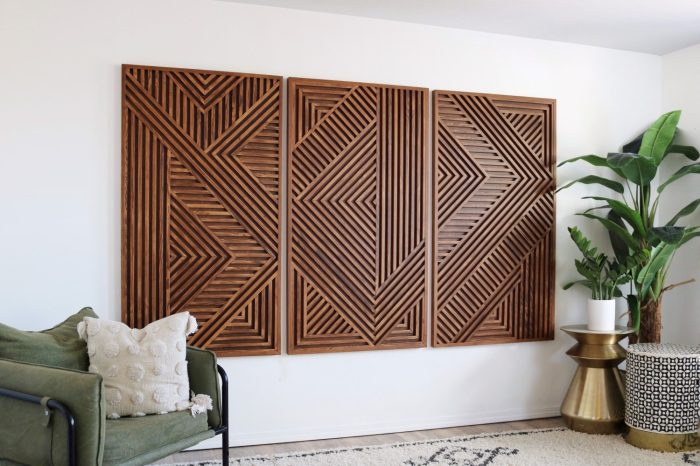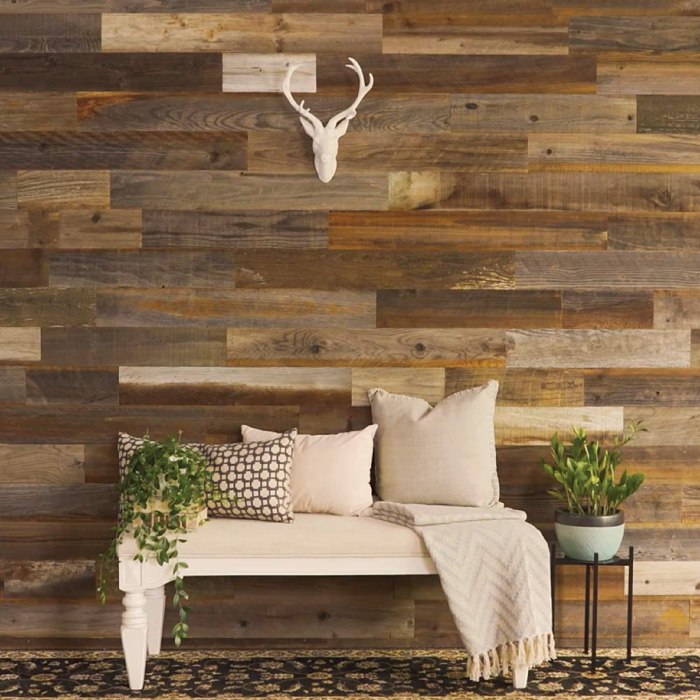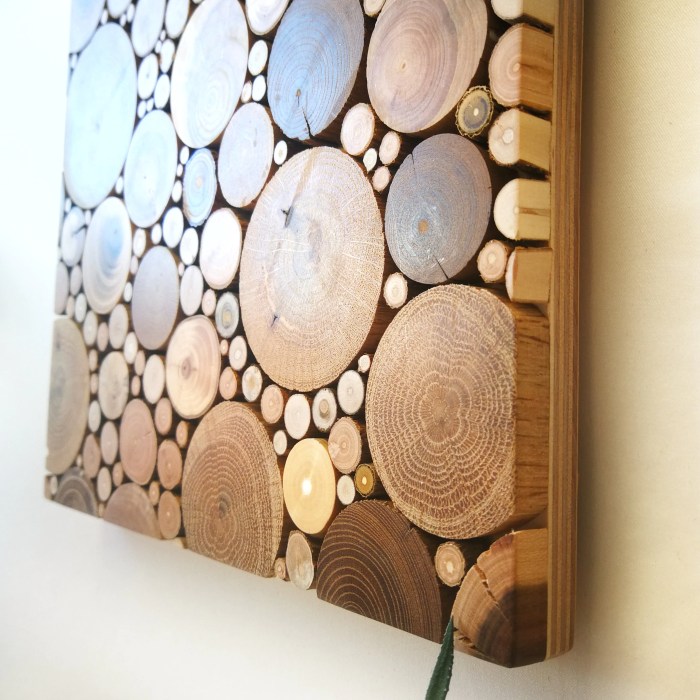Wood Wall Decoration offers a versatile and timeless way to elevate your home’s aesthetic. From rustic charm to modern minimalism, the possibilities are endless. This guide explores diverse styles, design concepts, materials, installation techniques, and market trends, empowering you to create a stunning focal point in any room.
We’ll delve into the specifics of crafting and installing various wood wall decorations, covering everything from selecting sustainable materials and applying the perfect finish to understanding pricing and current design trends. Whether you’re a seasoned DIY enthusiast or a novice decorator, this comprehensive resource will equip you with the knowledge and inspiration to transform your walls.
Design and Aesthetics

Wood wall decorations offer a versatile and visually appealing way to enhance any interior space. Their natural beauty, combined with the potential for diverse design approaches, allows for seamless integration into a variety of interior design styles. The careful selection of wood type, finish, and design can dramatically impact the overall aesthetic of a room, creating a focal point or subtly complementing existing décor.
Three Unique Wood Wall Decoration Concepts
This section details three distinct wood wall decoration concepts, each tailored to a specific interior design style: Farmhouse, Scandinavian, and Industrial. These examples illustrate the adaptability of wood as a decorative material and demonstrate how design choices can effectively reflect different aesthetic preferences.
- Farmhouse Style: Reclaimed Wood Wall Panel with Hanging Planters. This design utilizes reclaimed barn wood, approximately 48 inches wide by 36 inches high, with a distressed, whitewashed finish. The wood planks are arranged horizontally, creating a rustic texture. Small, galvanized metal hanging planters are affixed to the panel, adding a touch of greenery and enhancing the farmhouse aesthetic. The overall effect is a charming and welcoming feature wall.
- Scandinavian Style: Light Oak Geometric Wall Art. This concept involves a minimalist approach, using light-colored oak wood cut into geometric shapes (circles, squares, and triangles) of varying sizes. These shapes are arranged on a white backdrop, creating a clean and modern look. The wood is finished with a clear coat to highlight its natural grain and light color. The dimensions would be approximately 24 inches by 36 inches.
The simplicity of the design reflects the Scandinavian emphasis on functionality and natural elements.
- Industrial Style: Metal and Wood Shelf with Exposed Pipes. This design incorporates a blend of materials, combining reclaimed wood planks with exposed metal pipes and fittings. The wood planks, approximately 60 inches wide by 12 inches deep, form a floating shelf. Black metal pipes are used as supports, creating a raw and industrial look. The wood is stained a dark brown or black to complement the metal.
The overall dimension of the shelf is approximately 60 inches wide by 12 inches deep by 10 inches high. The exposed pipes and dark finish emphasize the industrial style.
Color and Texture in Wood Wall Decorations
Color and texture play a pivotal role in determining the visual impact of wood wall decorations. The choice of wood type significantly influences texture, ranging from the smooth surface of polished maple to the rough, rustic texture of reclaimed wood. Color can be manipulated through staining, painting, or whitewashing, allowing for a wide range of aesthetic possibilities. For example, a dark-stained wood panel can create a dramatic and sophisticated atmosphere, while a light-colored, whitewashed piece can contribute to a brighter, more airy feel.
The interplay of color and texture creates depth and visual interest, enhancing the overall aesthetic appeal of the decoration.
Wood Wall Decorations in Different Room Settings
Wood wall decorations can be successfully incorporated into various room settings, adding warmth, character, and visual interest. The specific design and style should be carefully considered to complement the existing décor and function of the space.
- Living Room: A large, reclaimed wood wall panel can serve as a striking focal point above a fireplace or sofa, creating a rustic or industrial vibe. Alternatively, a collection of smaller, geometric wood pieces can add a touch of modern elegance.
- Bedroom: A simple, light-colored wood headboard or a smaller, decorative wood panel above the bed can add warmth and visual interest to a bedroom without overwhelming the space. The texture and color of the wood should complement the overall bedroom palette.
- Dining Room: A rustic wood wall shelf can display decorative items or serve as a functional space for storing wine glasses or serving dishes. This adds both visual appeal and practical functionality to the dining area.
Materials and Sourcing

Creating stunning and sustainable wood wall decorations requires careful consideration of the materials used and their origin. Choosing ethically sourced wood not only reduces environmental impact but also ensures the longevity and beauty of your finished piece. The selection of wood type and finish significantly influences the final aesthetic and durability of the wall decoration.Sustainable and ethically sourced wood options offer a range of aesthetic and environmental benefits.
By prioritizing responsible forestry practices, we can minimize the negative impact on ecosystems and support businesses committed to environmental stewardship.
Sustainable Wood Options
Selecting wood from responsibly managed forests is crucial for creating eco-friendly wall decorations. This involves choosing wood certified by organizations like the Forest Stewardship Council (FSC) which ensures that the wood comes from forests managed according to strict environmental and social standards. Examples of sustainable wood species include bamboo, which is a rapidly renewable resource, and reclaimed wood, which repurposes materials that would otherwise be discarded, reducing waste and conserving resources.
Other sustainable options might include sustainably harvested hardwoods like oak or maple from forests with responsible management plans. The choice depends on the desired aesthetic and the availability of certified wood in your region.
Wood Finish Advantages and Disadvantages
The choice of wood finish significantly impacts the final look and durability of your wall decoration. Different finishes offer unique advantages and disadvantages that should be considered based on the project’s specific needs and the desired aesthetic.
| Finish | Advantages | Disadvantages |
|---|---|---|
| Varnish | Provides a protective layer, enhances natural wood grain, offers water resistance. | Can yellow over time, may require multiple coats for complete coverage, can feel less natural. |
| Stain | Enhances wood color and grain, allows for customization of color, penetrates the wood for deeper color. | Can raise the wood grain, may require sanding between coats, may not provide as much protection as varnish. |
| Paint | Provides complete color coverage, excellent protection, easy to apply. | Hides the natural wood grain, can chip or peel over time, may require more preparation than other finishes. |
Preparing Wood for Wall Decoration
Proper preparation of the wood is essential for creating a high-quality, long-lasting wall decoration. This process ensures a smooth surface, enhances adhesion of the finish, and ultimately contributes to the overall aesthetic appeal of the final product.
- Sanding: Begin by sanding the wood to remove any imperfections, splinters, or rough edges. Start with coarser grit sandpaper (e.g., 80-grit) and gradually move to finer grits (e.g., 120-grit, then 220-grit) for a smooth finish. This step is crucial for achieving a professional look and ensuring a uniform application of the finish.
- Cleaning: After sanding, thoroughly clean the wood surface to remove any dust or debris. A tack cloth or a slightly damp cloth is ideal for this purpose. Removing dust particles prevents them from interfering with the adhesion of the finish.
- Priming (if necessary): For certain wood types or finishes (especially paint), applying a primer can improve adhesion and create a more uniform surface. A primer helps to seal the wood and prevent the absorption of the finish, leading to a more even and consistent color.
- Applying Finish: Apply the chosen finish (varnish, stain, or paint) according to the manufacturer’s instructions. Multiple thin coats are generally better than one thick coat to prevent dripping and ensure even coverage. Allow each coat to dry completely before applying the next.
- Finishing Touches: Once the finish is dry, lightly sand with very fine grit sandpaper (e.g., 320-grit) to smooth out any imperfections. This step is optional but can create an exceptionally smooth surface. Finally, clean the surface again to remove any sanding dust before installation.
Installation and Maintenance: Wood Wall Decoration

Proper installation and regular maintenance are crucial for preserving the beauty and longevity of your wood wall decorations. Understanding the different methods for installation and cleaning will ensure your investment remains a stunning focal point in your home for years to come. This section details safe installation techniques and effective cleaning methods for various types of wood wall decorations.
Installing Wood Wall Decorations
Securely attaching your wood wall decoration depends heavily on its size, weight, and the type of wall it’s being affixed to. For lighter pieces, adhesive methods might suffice. Heavier items, however, require more robust solutions like screws or wall anchors. Always check the load-bearing capacity of your wall before beginning installation.
- Hanging Decorations: For hanging decorations, use picture hooks or wire appropriate for the weight of the piece. Ensure the hook is securely fastened into a wall stud for optimal support. For heavier items, consider using multiple hanging points or heavier-duty hooks designed for the weight. Always pre-drill pilot holes to prevent wood splitting, especially with harder woods.
- Directly Affixed Decorations: For decorations designed to be directly affixed to the wall, strong adhesive is often sufficient. Choose a high-quality adhesive specifically designed for wood and the type of wall surface. Ensure the surface is clean and dry before applying the adhesive. For larger or heavier pieces, consider using additional support such as screws or brackets to reinforce the adhesive bond.
- Using Wall Anchors: If you’re hanging a heavy piece on drywall, wall anchors are essential. Select anchors appropriate for the weight and type of wall. Follow the manufacturer’s instructions carefully for proper installation. Ensure the anchor is firmly seated before hanging the decoration.
Cleaning and Maintaining Wood Wall Decorations
Regular cleaning prevents dust and grime buildup, preserving the natural beauty of the wood. Different cleaning methods are suitable for different finishes. Avoid harsh chemicals or abrasive cleaners that could damage the wood’s finish.
- Dusting: Regularly dust your wood decorations with a soft, dry cloth or a feather duster. This prevents the accumulation of dust and debris.
- Cleaning: For more thorough cleaning, use a slightly damp (not wet) cloth with a mild soap solution. Gently wipe the surface, paying attention to crevices. Always test the cleaning solution on an inconspicuous area first to ensure it doesn’t damage the finish.
- Polishing: After cleaning, you can apply a wood polish or furniture oil to restore shine and protect the wood. Follow the manufacturer’s instructions carefully. Avoid using excessive amounts of polish.
Preventing Damage to Wood Wall Decorations
Taking preventative measures significantly reduces the risk of damage to your wood wall art. Understanding common issues and their solutions is crucial for long-term preservation.
- Direct Sunlight: Prolonged exposure to direct sunlight can fade the color and dry out the wood. Avoid placing decorations in areas with intense sunlight. Consider using UV-protective film or coating if necessary.
- Humidity and Temperature Fluctuations: Extreme temperature changes and high humidity can cause wood to warp or crack. Maintain a stable indoor environment to minimize these risks.
- Impact Damage: Protect your decorations from accidental impacts. Consider placing them in areas with less foot traffic or where they are less likely to be bumped or knocked. If using glass in conjunction with the wood, ensure the glass is well-secured to avoid shattering.
- Pest Infestation: Wood is susceptible to pests such as woodworms. Regularly inspect your decorations for signs of infestation and take appropriate action if necessary. Using wood preservatives during the creation process can help prevent this issue.
Ultimately, incorporating wood wall decorations into your home provides a unique opportunity to blend style, functionality, and personal expression. By carefully considering design aesthetics, material choices, and installation methods, you can create a visually captivating and long-lasting addition to your living space. This guide has equipped you with the knowledge to embark on your own wood wall decoration project with confidence, transforming your walls into stunning works of art.